1. Aglietti P, Buzzi R, Insall JN. Disorders of the patellofemoral joint. In : Insall JN, Scott WN, editors. Surgery of the Knee. 3rd ed. New York, NY: Churchill Livingstone;2001. p. 592–623.
2. Aulisa AG, Falciglia F, Giordano M, Savignoni P, Guzzanti V. Galeazzi's modified technique for recurrent patella dislocation in skeletally immature patients. J Orthop Sci. 2012; 17(2):148–155. PMID:
22234373.

3. Biedert RM, Bachmann M. Anterior-posterior trochlear measurements of normal and dysplastic trochlea by axial magnetic resonance imaging. Knee Surg Sports Traumatol Arthrosc. 2009; 17(10):1225–1230. PMID:
19495725.

4. Blumensaat C, Ergenbn D. Patellofemoral disorders: physical and radiographic evaluation. Chir U Orthop. 1938; 31:149–223.
5. Colvin AC, West RV. Patellar instability. J Bone Joint Surg Am. 2008; 90(12):2751–2762. PMID:
19047722.

6. Conlan T, Garth WP Jr, Lemons JE. Evaluation of the medial soft-tissue restraints of the extensor mechanism of the knee. J Bone Joint Surg Am. 1993; 75(5):682–693. PMID:
8501083.

7. Camanho GL, Bitar AC, Hernandez AJ, Olivi R. Medial patellofemoral ligament reconstruction: a novel technique using the patellar ligament. Arthroscopy. 2007; 23(1):108.e1–108.e4. PMID:
17210439.

8. Tensho K, Akaoka Y, Shimodaira H, et al. What components comprise the measurement of the tibial tuberosity-trochlear groove distance in a patellar dislocation population? J Bone Joint Surg Am. 2015; 97(17):1441–1448. PMID:
26333740.

9. Kuroda R, Kambic H, Valdevit A, Andrish JT. Articular cartilage contact pressure after tibial tuberosity transfer: a cadaveric study. Am J Sports Med. 2001; 29(4):403–409. PMID:
11476376.
10. Nakagawa K, Wada Y, Minamide M, Tsuchiya A, Moriya H. Deterioration of long-term clinical results after the Elmslie-Trillat procedure for dislocation of the patella. J Bone Joint Surg Br. 2002; 84(6):861–864. PMID:
12211679.

11. Parikh S, Noyes FR. Patellofemoral disorders: role of computed tomography and magnetic resonance imaging in defining abnormal rotational lower limb alignment. Sports Health. 2011; 3(2):158–169. PMID:
23016003.
12. Goutallier D, Bernageau J, Lecudonnec B. The measurement of the tibial tuberosity: patella groove distanced technique and results (author's transl). Rev Chir Orthop Reparatrice Appar Mot. 1978; 64(5):423–428. PMID:
152950.
13. Dejour H, Walch G, Nove-Josserand L, Guier C. Factors of patellar instability: an anatomic radiographic study. Knee Surg Sports Traumatol Arthrosc. 1994; 2(1):19–26. PMID:
7584171.

14. Paley D, Herzenberg JE, Tetsworth K, McKie J, Bhave A. Deformity planning for frontal and sagittal plane corrective osteotomies. Orthop Clin North Am. 1994; 25(3):425–465. PMID:
8028886.

15. Stephen JM, Lumpaopong P, Dodds AL, Williams A, Amis AA. The effect of tibial tuberosity medialization and lateralization on patellofemoral joint kinematics, contact mechanics, and stability. Am J Sports Med. 2015; 43(1):186–194. PMID:
25367019.

16. Schoettle PB, Zanetti M, Seifert B, Pfirrmann CW, Fucentese SF, Romero J. The tibial tuberosity-trochlear groove distance; a comparative study between CT and MRI scanning. Knee. 2006; 13(1):26–31. PMID:
16023858.

17. Cibulka MT. Determination and significance of femoral neck anteversion. Phys Ther. 2004; 84(6):550–558. PMID:
15161420.

18. Goutallier D, Van Driessche S, Manicom O, Sariali E, Bernageau J, Radier C. Influence of lower-limb torsion on long-term outcomes of tibial valgus osteotomy for medial compartment knee osteoarthritis. J Bone Joint Surg Am. 2006; 88(11):2439–2447. PMID:
17079402.

19. Balcarek P, Jung K, Ammon J, et al. Anatomy of lateral patellar instability: trochlear dysplasia and tibial tubercle-trochlear groove distance is more pronounced in women who dislocate the patella. Am J Sports Med. 2010; 38(11):2320–2327. PMID:
20713643.
20. Balcarek P, Jung K, Frosch KH, Sturmer KM. Value of the tibial tuberosity-trochlear groove distance in patellar instability in the young athlete. Am J Sports Med. 2011; 39(8):1756–1761. PMID:
21566067.

21. Dickens AJ, Morrell NT, Doering A, Tandberg D, Treme G. Tibial tubercle-trochlear groove distance: defining normal in a pediatric population. J Bone Joint Surg Am. 2014; 96(4):318–324. PMID:
24553888.

22. Ando T. Factors affecting the rectus femoris-patellar tendon Q-angle, measured using a computed tomographic scan. J Orthop Sci. 1999; 4(2):73–77. PMID:
10199983.

23. Cameron JC, Saha S. External tibial torsion: an underrecognized cause of recurrent patellar dislocation. Clin Orthop Relat Res. 1996; (328):177–184. PMID:
8653953.

24. Drexler M, Dwyer T, Dolkart O, et al. Tibial rotational osteotomy and distal tuberosity transfer for patella subluxation secondary to excessive external tibial torsion: surgical technique and clinical outcome. Knee Surg Sports Traumatol Arthrosc. 2014; 22(11):2682–2689. PMID:
23740327.

25. Sanfridsson J, Arnbjornsson A, Friden T, Ryd L, Svahn G, Jonsson K. Femorotibial rotation and the Q-angle related to the dislocating patella. Acta Radiol. 2001; 42(2):218–224. PMID:
11259951.

26. Paulos L, Swanson SC, Stoddard GJ, Barber-Westin S. Surgical correction of limb malalignment for instability of the patella: a comparison of 2 techniques. Am J Sports Med. 2009; 37(7):1288–1300. PMID:
19491333.
27. Schueda MA, Astur DC, Bier RS, Bier DS, Astur N, Cohen M. Use of computed tomography to determine the risk of patellar dislocation in 921 patients with patellar instability. Open Access J Sports Med. 2015; 6:55–62. PMID:
25784822.
28. Kim DK, Seo MC, Song SJ, Kim KI. Are Korean patients different from other ethnic groups in total knee arthroplasty? Knee Surg Relat Res. 2015; 27(4):199–206. PMID:
26675374.

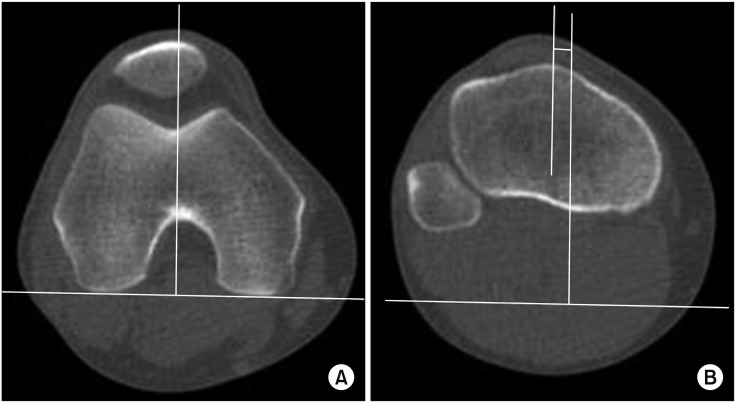
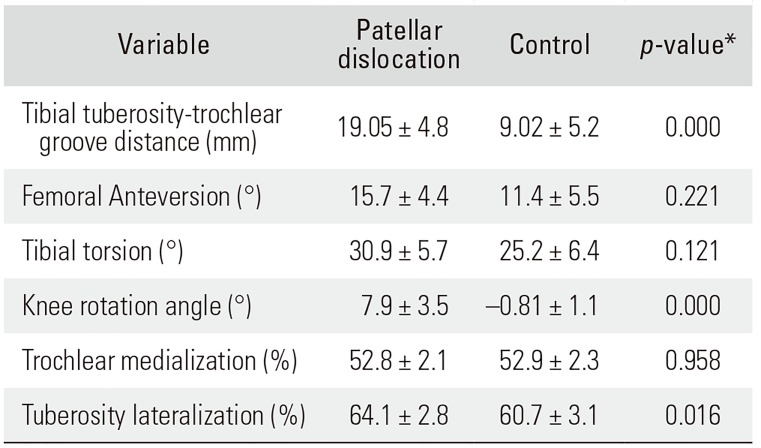





 PDF
PDF ePub
ePub Citation
Citation Print
Print


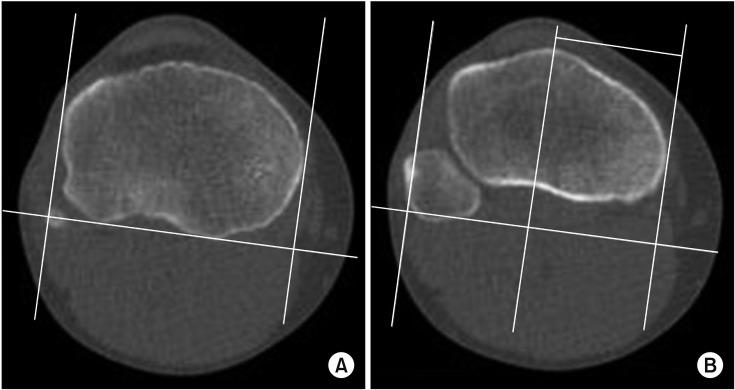
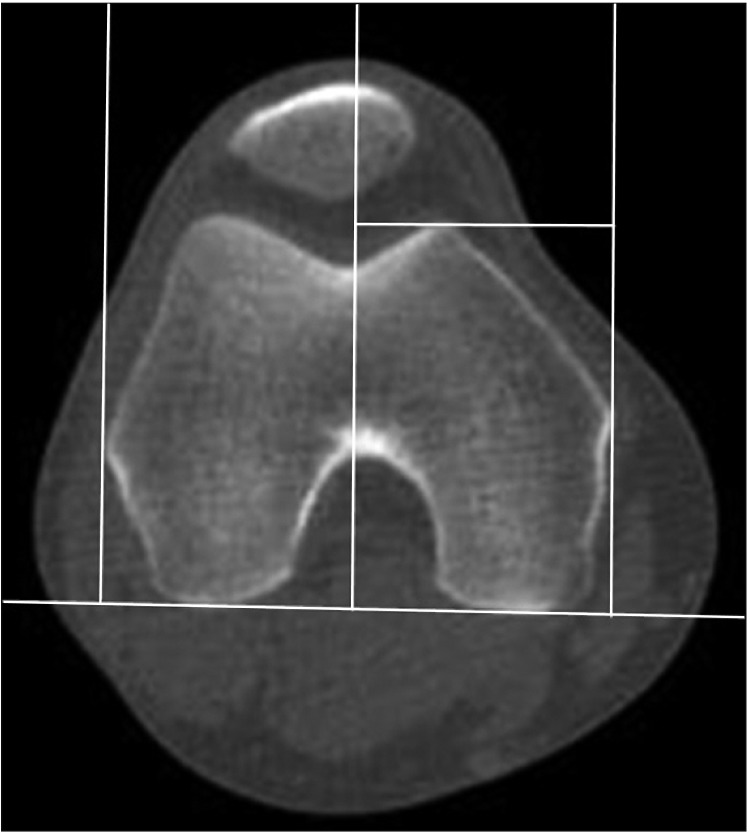
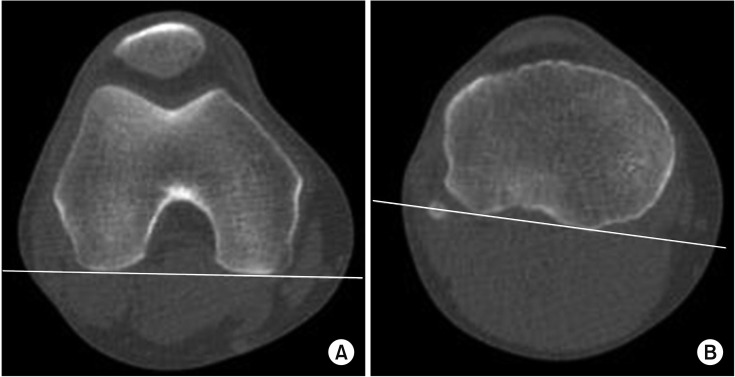
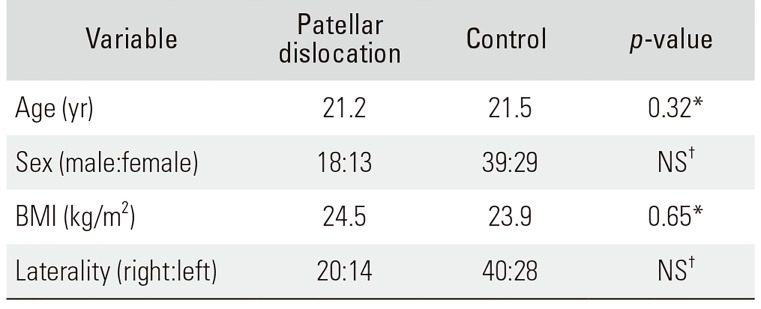
 XML Download
XML Download